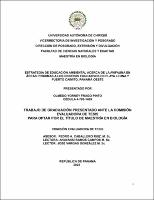| dc.contributor.advisor | Caballero Ruiz, Pedro A. | |
| dc.contributor.author | Frago Pinto, Olmedo Yorney | |
| dc.date.accessioned | 2023-07-07T18:36:43Z | |
| dc.date.available | 2023-07-07T18:36:43Z | |
| dc.date.issued | 2023 | |
| dc.identifier.uri | http://jadimike.unachi.ac.pa/handle/123456789/777 | |
| dc.description.abstract | La diversidad de aves puede aprovecharse para enseñar contenidos curriculares.
Se diseñó una estrategia didáctica de educación ambiental basada en las aves,
contextualizada y correlacionada con el programa de estudios de 6°, para promover
adquisición de nuevos conocimientos y competencias en estudiantes de centros
educativos de Playa Leona y Puerto Caimito, Panamá Oeste.
Se censó las aves con mayor presencia mediante el método de conteo en puntos
fijos propuesto por Ralph et al. 1996, en un perímetro de 500 m en los centros
educativos de Playa Leona y Puerto Caimito; 100 m fue la distancia entre cada uno
de los 6 puntos de conteo por área, teniendo 4 réplicas para cada punto; se
determinó saberes de 32 docentes y expertos, con encuestas y técnica de grupo
focal, se identificó contenidos programáticos de sexto grado que pueden
correlacionarse con la avifauna producto del censo, se diseñó actividades lúdicas,
un catálogo pictórico contextualizado al contenido programático de Matemática,
Español y Ciencias Naturales de 6°.
En el área de Playa Leona, se observó 65 especies de aves durante el censo, y en
Puerto Caimito, 84 especies siendo de mayor presencia Coragyps atratus,
Phalacrocorax brasilianus, Ardea alba, Quiscalus mexicanus, Fregata magnificens
y Buteogallus anthracinus. La hoja de ruta de la estrategia contempla actividades
lúdicas con aves en temas como comunicación verbal y no verbal, ortografía,
narración; números naturales, fracciones, estadística, los sentidos, biodiversidad. | es_ES |
| dc.description.abstract | The diversity of birds can be used to teach curricular content. A didactic strategy of
environmental education based on birds, contextualized, and correlated with the 6th
grade study program, was designed to promote the acquisition of new knowledge
and skills in students from educational centers in Playa Leona and Puerto Caimito,
Panamá Oeste(Western Panamá).
The birds with the greatest presence were counted using the fixed point counting
method proposed by Ralph et al. 1996, in a perimeter of 500 m in the educational
centers of Playa Leona and Puerto Caimito; 100 m was the distance between each
of the 6 counting points per area, having 4 replicates for each point; The knowledge
of 32 teachers and experts was determined with surveys and a focus group
technique, sixth grade programmatic content was identified that can be correlated
with the avifauna product of the census, playful activities were designed, a pictorial
catalog contextualized to the programmatic content of mathematics, Spanish and
6th grade natural sciences.
In the area of Playa Leona, 65 species of birds were observed during the census,
and in Puerto Caimito, 84 species, the most prevalent being Coragyps atratus,
Phalacrocorax brasilianus, Ardea alba, Quiscalus mexicanus, Fregata magnificens,
and Buteogallus anthracinus. The strategy roadmap includes playful activities with
birds on topics such as verbal and non-verbal Communication, spelling, Narration,
Natural Numbers, fractions, statistics, the Senses, Biodiversity. | en_US |
| dc.language.iso | es | es_ES |
| dc.publisher | Universidad Autónoma de Chiriquí | es_ES |
| dc.subject | FAUNA FORESTAL -- PANAMÁ | es_ES |
| dc.subject | AVIFAUNA -- PANAMÁ OESTE | es_ES |
| dc.subject | EDUCACIÓN AMBIENTAL -- AVIFAUNA -- PANAMÁ OESTE | es_ES |
| dc.subject | TESIS MAESTRÍA EN BIOLOGÍA | es_ES |
| dc.title | Estrategia de educación ambiental acerca de la avifauna en áreas próximas a los centros educativos en Playa Leona y Puerto Caimito, Panamá Oeste. | es_ES |
| dc.type | Thesis | es_ES |

